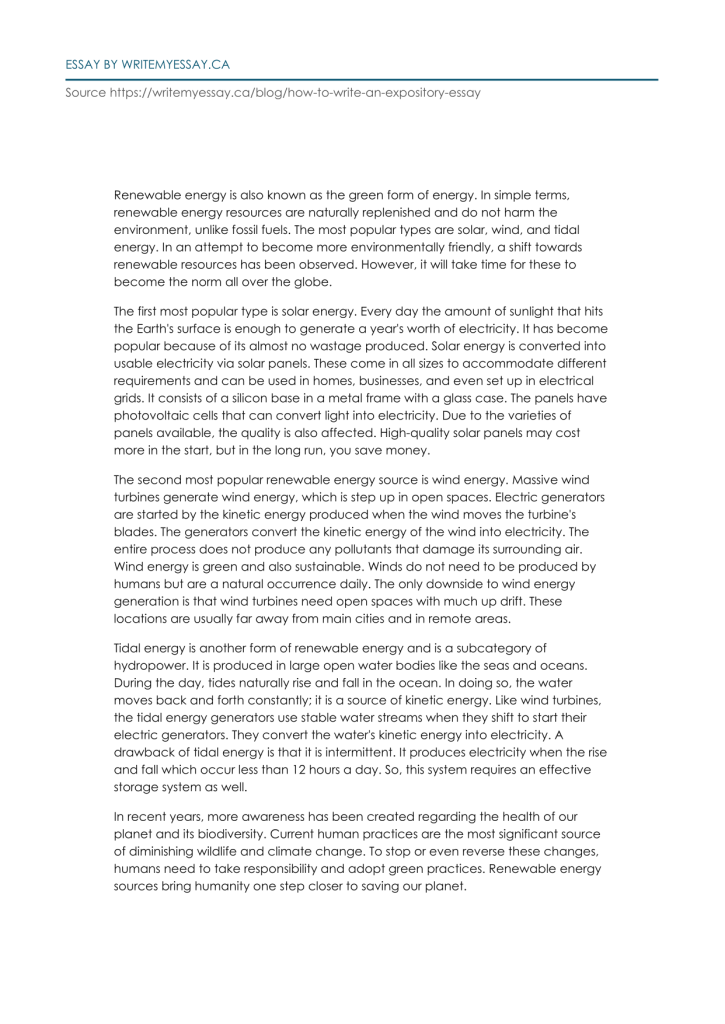
How to Write an Expository Essay

Table of Contents
- What Is An Expository Essay
- Why Is It Important To Know How To Write An Expository Essay
- Expository Essay Structure And Format
- How To Write The Body Paragraphs
- How To Write The Conclusion For An Expository Essay
- Tips For A Great Expository Essay
- Short Example Of An Expository Essay
You can ask any student how they feel about essay writing assignments, and you will get the same reaction of groans and murmurs of why. Essay writing is a challenging task that students have to write at every academic level, much to their dismay. Due to the technicalities of essay writing that students do not understand, they often wish to have someone write for them.
What is an expository essay?
According to Merriam-webster, expository means a form of writing that explains something. In this sense, an expository essay definition would be an essay that provides an in-depth explanation of a topic or scenario. Unlike a critical essay, it does not aim to choose a side or prove a point but rather to give a 360-degree view on the topic.
Many students find it challenging to comprehend how to differentiate between different types of essays and write them. Furthermore, with part-time jobs and social lives, students find it hard to manage everything. At this point, many will think if they can pay to write an essay for them. The simple answer is yes by using essay writing services. These services exist solely to help students with all types of academic assignments, including essay writing.
Why is it important to know how to write an expository essay?
A student focuses more on getting done with the assignment rather than looking at the benefits of it. A college is where professors teach you about your subjects and groom you for the professional world. Instead of wondering what is an expository essay, focus on what it can teach you. The purpose of this particular paper is;
- To teach students how to explain scenarios and processes in detail, which is helpful for project proposals and meeting reports,
- To help them identify what type of information to include and how to exclude irrelevant or repetitive facts effectively,
- To teach students to separate their personal opinion about the situations from what they write,
- To help them eliminate bias. Many people unconsciously favor a bias, but they learn to write a balanced report with an expository essay structure, which helps them in the corporate world.
Expository essay structure and format
The expository essay format and structure are similar to a traditional essay. The structure will include five paragraphs, divided into three different sections. Each section focuses on a different element of the topic; two paragraphs are dedicated to the introduction and conclusion each, and the remaining three form the body of the paper.
How to write an outline
Creating an outline is an integral part of academic writing. It helps focuses a student’s thoughts and gives the document structure. An outline acts as the skeleton of the paper, so the information comes in an order that makes sense. In simple terms, it allows for the essay to have a natural flow of information instead of random facts mentioned here and there. An advantage of the outline is how it helps students avoid unnecessary repetition of facts, information, and statements.
A sample expository essay outline is as follows:
- Introduction,
- Background,
- Thesis statement,
- Body,
- Three paragraphs (each with the central theme and unbiased explanation),
- Conclusion.
How to start an expository essay
Many students do not know how to start an expository essay. The simple answer is to write the first part, which is the introduction. The introduction should consist of s brief description of the topic and then flow into the thesis statement. This statement sets the tone of the entire essay. The introduction is the first thing the reader will read, so it has to be exciting and grab the reader’s attention. A good introduction is not too long or short, but somewhat between 60 to 75 words.
How to write the body paragraphs
The body of the paper has three paragraphs. Each paragraph will have its theme and focus on one element. Start each paragraph with the theme statement and provide relevant details. Many writers recommend writing the expository essay introduction after the body as it is more convenient.
How to write the conclusion for an expository essay
If you look at expository essay examples, you will learn that they all have brief conclusions. The conclusion merges all your arguments into a neat paragraph. The conclusion should be kept brief with less than 65 words.
Tips for a great expository essay
Students always ask for tips on writing an academic paper. The following list has the best tips and tricks for expository essays:
- Jot down important points on the outline,
- Avoid figurative language,
- Avoid writing about personal opinion,
- Do not use very long sentences,
- Avoid complicated words,
- Conduct thorough research,
- Create the thesis statement before you write the introduction,
- Always proofread and edit.
Short example of an Expository essay

An example of an expository essay about renewable energy is as follows:
Renewable energy is also known as the green form of energy. In simple terms, renewable energy resources are naturally replenished and do not harm the environment, unlike fossil fuels. The most popular types are solar, wind, and tidal energy. In an attempt to become more environmentally friendly, a shift towards renewable resources has been observed. However, it will take time for these to become the norm all over the globe.
The first most popular type is solar energy. Every day the amount of sunlight that hits the Earth’s surface is enough to generate a year’s worth of electricity. It has become popular because of its almost no wastage produced. Solar energy is converted into usable electricity via solar panels. These come in all sizes to accommodate different requirements and can be used in homes, businesses, and even set up in electrical grids. It consists of a silicon base in a metal frame with a glass case. The panels have photovoltaic cells that can convert light into electricity. Due to the varieties of panels available, the quality is also affected. High-quality solar panels may cost more in the start, but in the long run, you save money.
The second most popular renewable energy source is wind energy. Massive wind turbines generate wind energy, which is step up in open spaces. Electric generators are started by the kinetic energy produced when the wind moves the turbine’s blades. The generators convert the kinetic energy of the wind into electricity. The entire process does not produce any pollutants that damage its surrounding air. Wind energy is green and also sustainable. Winds do not need to be produced by humans but are a natural occurrence daily. The only downside to wind energy generation is that wind turbines need open spaces with much up drift. These locations are usually far away from main cities and in remote areas.
Tidal energy is another form of renewable energy and is a subcategory of hydropower. It is produced in large open water bodies like the seas and oceans. During the day, tides naturally rise and fall in the ocean. In doing so, the water moves back and forth constantly; it is a source of kinetic energy. Like wind turbines, the tidal energy generators use stable water streams when they shift to start their electric generators. They convert the water’s kinetic energy into electricity. A drawback of tidal energy is that it is intermittent. It produces electricity when the rise and fall which occur less than 12 hours a day. So, this system requires an effective storage system as well.
In recent years, more awareness has been created regarding the health of our planet and its biodiversity. Current human practices are the most significant source of diminishing wildlife and climate change. To stop or even reverse these changes, humans need to take responsibility and adopt green practices. Renewable energy sources bring humanity one step closer to saving our planet.
Q&A
Students have many questions when it comes to writing an expository essay. Unfortunately, they do not have enough platforms to receive the answers they desire. So, to help you and other struggling students, we have answered the most commonly asked questions.
How do you start an expository essay?
Composing an essay starts before the actual writing process. You start with researching what topic to write on. To avoid writer’s block and save time, authors recommend creating an outline as it helps guide you and with the expository essay structure. You cannot down research points next to the headings in the outline as well. After you complete the research, you can begin by writing a rough draft of the body. We recommend writing the introduction after the body as it is a summary of the body paragraphs.
What is an example of an expository essay?
The name “expository essays” may confuse you, but it is not something unknown. Chances are you have encountered this type of document before your college assignments. When you have gotten a new electric heater or a vacuum, the instruction manual is an expository document. Even the assembly manuals with Ikea furniture qualify as one as it explains how to assemble the furniture. Newspaper articles are the closest expository documents to an essay for college.
How do you write a good expository paragraph?
It is usual for students to think about how to write an expository essay. The simple tip is to create a structure within paragraphs as well. Start If you are writing about how to do something, then break it down into three components. You can start each paragraph with a significant part in one sentence. You can further break it down and provide more detail, but remember to go from general to specific.
All this is hard to do, so if you need help with the writing process, you can always use WriteMyEssay. Writemyessay.ca is a paper writing service that specializes in academic assignments.
They work tirelessly to craft a document from scratch to ensure you get your money’s worth and more!




